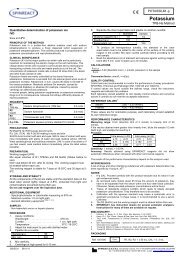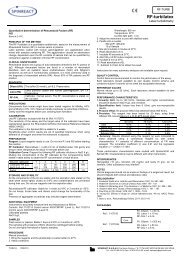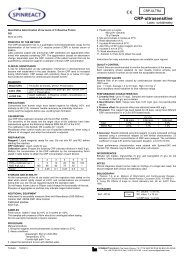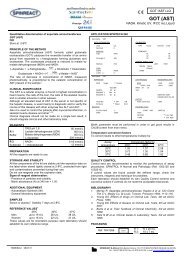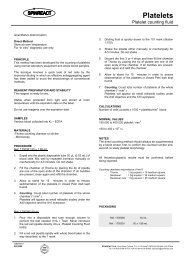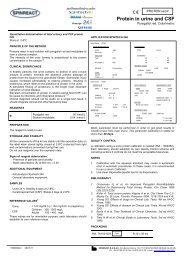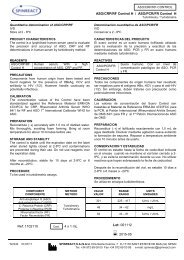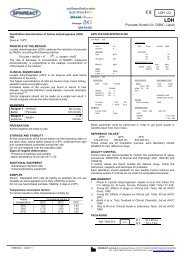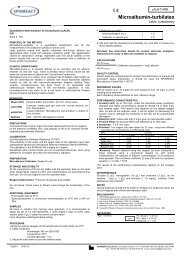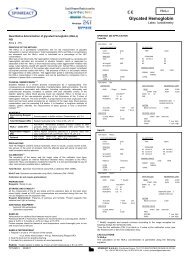Anti-globulina humana poliespecífica
Qualitative test for determination of the C,c,E,e antigen ... - Spinreact
Qualitative test for determination of the C,c,E,e antigen ... - Spinreact
You also want an ePaper? Increase the reach of your titles
YUMPU automatically turns print PDFs into web optimized ePapers that Google loves.
0843<br />
<strong>Anti</strong>-<strong>globulina</strong> <strong>humana</strong> <strong>poliespecífica</strong><br />
Tests de Coombs Directo e Indirecto<br />
Grupos sanguíneos<br />
Determinación cualitativa de anti-Ig G y anti-C3d humanos en<br />
hematíes<br />
IVD<br />
Conservar a 2-8ºC<br />
PRINCIPIO DEL MÉTODO<br />
Utilizando las técnicas recomendadas, los reactivos reaccionarán con inmuno<strong>globulina</strong> y/o<br />
complemento ligados a la superficies de los hematíes, provocando la aglutinación de las<br />
células sensibilizadas adyacentes. Las células no sensibilizadas no aglutinarán (ver<br />
Limitaciones).<br />
SIGNIFICADO CLÍNICO<br />
En 1945 Coombs, Mourant y Race descubrieron el uso de la anti-<strong>globulina</strong> <strong>humana</strong> para la<br />
detección de anticuerpos no aglutinantes de los hematíes. En 1957, Dacie y col. mostraron<br />
que los anticuerpos de un suero de anti<strong>globulina</strong> eran directamente contra ciertos<br />
componentes del complemento. Los reactivos anti<strong>globulina</strong> <strong>humana</strong> detectan tanto moléculas<br />
de anticuerpos no aglutinantes, como moléculas de complemento ligados a los hematíes<br />
siguiendo reacciones antígeno-anticuerpo in vivo o in vitro.<br />
REACTIVOS<br />
Los reactivos Spinreact <strong>Anti</strong>-<strong>globulina</strong> <strong>humana</strong> <strong>poliespecífica</strong> contienen anti-IgG derivadas de<br />
conejo, cuya actividad inespecífica ha sido eliminada por absorción y IgM monoclonal de ratón<br />
anti-C3d, clon BRIC-8. Los anticuerpos son diluidos en una solución tamponada que contiene<br />
albúmina bovina. Cada reactivo es suministrado en la dilución óptima para su utilización en<br />
todas las técnicas aquí recomendadas sin necesidad de diluciones o adiciones<br />
suplementarias. Ver el lote y caducidad de cada referencia en la etiqueta del vial.<br />
Reactivo Color Colorante utilizado<br />
<strong>Anti</strong><strong>globulina</strong> <strong>humana</strong> verde Verde Tartracina y azul patentado<br />
PRECAUCIONES<br />
1. Los reactivos son sólo para uso en diagnóstico in vitro.<br />
2. Si el vial del reactivo está roto o agrietado, descartar inmediatamente su contenido.<br />
3. No utilizar reactivos caducados. (ver la etiqueta de vial).<br />
4. No utilizar reactivos que presenten precipitados.<br />
5. La manipulación del reactivo debe realizarse con la apropiada indumentaria de protección, tales<br />
como guantes desechables y bata de laboratorio.<br />
6. Los reactivos han sido filtrados a través de cápsulas de 0.2 µm para reducir la carga biológica.<br />
Una vez abierto el vial, el contenido debe permanecer viable hasta la fecha de caducidad,<br />
siempre y cuando no haya una marcada turbidez la cual podría ser indicativa de deterioración o<br />
contaminación del reactivo.<br />
7. Los reactivos contienen < 0.1% de azida sódica. La azida sódica puede ser tóxica, si se ingiere<br />
y puede reaccionar con cobre o plomo de las tuberías y formar azidas metálicas explosivas. En<br />
caso de eliminación del producto, hacerlo con abundante agua del grifo.<br />
8. Ningún método puede garantizar que los productos derivados de fuentes <strong>humana</strong>s o animales<br />
están libres de enfermedades infecciosas. Manipular y desechar con precaución los viales y su<br />
contenido.<br />
9. Para mayor información sobre la eliminación del producto o descontaminación en caso de<br />
derrame, ver las fichas de seguridad.<br />
NOTAS<br />
1. Se recomienda la utilización de un control positivo (<strong>Anti</strong>-D débil 0.1 IU/mL) y un control<br />
negativo (suero inerte) para testar de forma paralela en cada lote de tests. Los tests<br />
deben considerarse inválidos si los controles no muestran los resultados esperados.<br />
2. Las técnicas anti<strong>globulina</strong>s sólo pueden considerarse válidas si todos los tests<br />
negativos reaccionan positivamente con hematíes sensibilizados con IgG.<br />
3. En las técnicas recomendadas un volumen es aproximadamente 40µl utilizando el<br />
gotero suministrado.<br />
4. La utilización de los reactivos y la interpretación de los resultados deben llevarse a<br />
cabo por personal cualificado y formado de acuerdo a los requisitos del país dónde los<br />
reactivos están siendo utilizados. El usuario debe determinar la idoneidad de los<br />
reactivos para otras técnicas.<br />
CONSERVACIÓN<br />
No congelar. Los viales de reactivo deben ser conservados a 2-8ºC. Almacenamientos<br />
prolongados, a temperaturas fuera de este rango, pueden provocar una aceleración de la<br />
pérdida de reactividad.<br />
MATERIAL NECESARIO<br />
Tubos de vidrio (10 x 75 mm o 12 x 75 mm).<br />
Centrífuga de tubos.<br />
Pipetas volumétricas.<br />
Tampón fosfato salino (PBS): NaCl 0.9%, pH 7.0 ± 0.2 a 22ºC ± 1ºC.<br />
Hematíes sensibilizados con IgG<br />
Suero de anticuerpo inerte.<br />
<strong>Anti</strong>-D débil.<br />
Baño caliente o incubador de calor seco equilibrado a 37ºC ± 2ºC.<br />
Lavador de células Coombs<br />
Solución lisante (LISS), ej.: REF de Spinreact. 1700080.<br />
MUESTRAS<br />
Las muestras deben tratarse asépticamente en EDTA para prevenir la unión in vitro del<br />
complemento y analizarse en 24 horas. En caso que el EDTA no esté disponible, es preferible<br />
muestras tratadas en ACD. CPD o CPDA-1, que muestras coaguladas, Si sólo se dispone de<br />
muestras coaguladas, no refrigerar antes de analizar. Todas las muestras de sangre deben<br />
ser lavadas con PBS al menos dos veces antes de realizar el test.<br />
PROCEDIMIENTO<br />
A. Técnica anti<strong>globulina</strong> directa (DAT)<br />
1. Lavar 4 veces en PBS los hematíes a testar, cuidando de decantar la solución salina<br />
entre lavados y resuspendiendo el botón celular tras cada lavado. Tras el último lavado,<br />
decantar completamente la solución salina.<br />
2. Añadir 2 volúmenes de anti<strong>globulina</strong> <strong>humana</strong> a cada botón celular.<br />
3. Mezclar minuciosamente y centrifugar los tubos durante 20 segundos a 1000 rcf (g) o a<br />
una fuerza y tiempo alternativos adecuados.<br />
4. Resuspender cuidadosamente el botón celular y leer macroscópicamente por<br />
aglutinación.<br />
B. Técnica anti<strong>globulina</strong> indirecta (NISS IAT)<br />
1. Preparar una suspensión al 2-3% de hematíes lavados en PBS.<br />
2. Depositar en un tubo identificado: 2 volúmenes del suero a testar y 1 volumen de la<br />
suspensión de hematíes a testar.<br />
3. Mezclar minuciosamente e incubar a 37ºC durante 15 minutos.<br />
4. Lavar 4 veces los hematíes en PBS cuidando de decantar la solución salina entre<br />
lavados y resuspendiendo el botón celular tras cada lavado. Tras el último lavado,<br />
decantar completamente la solución salina.<br />
5. Añadir 2 volúmenes de anti<strong>globulina</strong> <strong>humana</strong> a cada botón celular.<br />
6. Mezclar minuciosamente y centrifugar los tubos durante 20 segundos a 1000 rcf (g) o a<br />
una fuerza y tiempo alternativos adecuados.<br />
7. Resuspender cuidadosamente el botón celular y leer macroscópicamente por<br />
aglutinación.<br />
C. Técnica anti<strong>globulina</strong> indirecta LISS (LISS IAT)<br />
1. Preparar una suspensión al 1.5 - 2% de hematíes a testar lavados en solución lisante.<br />
2. Depositar en un tubo identificado: 2 volúmenes del suero a testar y 2 volúmenes de la<br />
suspensión de hematíes a testar.<br />
3. Mezclar minuciosamente e incubar a 37ºC durante 15 minutes.<br />
4. Seguir los pasos 4 a 7 de la técnica (NISS IAT)<br />
INTERPRETACIÓN DE LOS RESULTADOS<br />
1. Positivo: La aglutinación de los hematíes a testar constituye un resultado positivo y<br />
dentro de las limitaciones aceptadas para el procedimiento del test, indica la presencia<br />
IgG y/o complemento (C3) en los hematíes a testar.<br />
2. Negativo: La ausencia de aglutinación de los hematíes a testar constituye un resultado<br />
negativo y dentro de las limitaciones aceptadas para el procedimiento de la técnica,<br />
indica la ausencia en hematíes de IgG y/o complemento (C3) en los hematíes a testar.<br />
Estabilidad de las reacciones<br />
1. Las etapas de lavado deben completarse sin interrupción alguna y la centrifugación y lectura<br />
debe realizarse inmediatamente tras la adición del reactivo. Los retrasos pueden suponer la<br />
disociación de los complejos antígeno-anticuerpo, causando falsos negativos o resultados<br />
positivos débiles.<br />
2. Los resultados, de tests realizados a otras temperaturas de las aquí recomendadas, deben ser<br />
interpretados con cautela.<br />
LIMITACIONES<br />
1. Los hematíes que resultan positivos por DAT debido a un recubrimiento de IgG, no<br />
pueden ser tipados por las técnicas <strong>Anti</strong><strong>globulina</strong> Indirectas.<br />
2. Un DAT positivo por sensibilización con complemento puede no reflejar la fijación in<br />
vivo de complemento, si las células a atestar provienen de una muestra coagulada<br />
refrigerada.<br />
3. Lavados inadecuados en técnicas anti<strong>globulina</strong> indirectas pueden neutralizar el reactivo<br />
antigobulina <strong>humana</strong>.<br />
4. Tras completar la fase de lavado, el exceso de fase salina residual puede diluir la<br />
anti<strong>globulina</strong> <strong>humana</strong>, reduciendo su potencia.<br />
5. Un resultado negativo por técnicas anti<strong>globulina</strong> directa no excluye necesariamente un<br />
diagnóstico clínico del Síndrome hemolítico ABO del Recién Nacido o Anemia<br />
Hemolítica Autoinmune. Tampoco no descarta de HDN, especialmente si se sospecha<br />
de incompatibilidad ABO.<br />
6. Puede también ocurrir falsos resultados positivos o negativos debido a:<br />
Contaminación de los materiales del test<br />
Conservación inadecuada, concentración celular, tiempo o temperatura de<br />
incubación<br />
Centrifugación inapropiada o excesiva<br />
7. El usuario es responsable del funcionamiento de los reactivos en cualquier otro método<br />
distinto de los mencionados aquí.<br />
8. Cualquier desviación de las técnicas, aquí detalladas, debería ser validada antes de su<br />
utilización 9 .<br />
CARACTERÍSTICAS DEL MÉTODO<br />
1. Los reactivos han sido caracterizados para todos los procedimientos aquí<br />
mencionados.<br />
2. Préviamente a su liberación, cada lote de Spinreact <strong>Anti</strong><strong>globulina</strong> <strong>humana</strong> es testado a<br />
través de las técnicas recomendadas frente a un panel de hematíes <strong>Anti</strong>-D, <strong>Anti</strong>-K y<br />
<strong>Anti</strong>-Fy a , a fin comprovar la adecuada reactividad.<br />
3. La potencia anti-IgG y anti-C3d ha sido testada frente al estándar de referencia de<br />
potencia mínima, <strong>Anti</strong>-AHG 96/666,procedente del National Institute of Biological<br />
Standards and Controls (NIBSC).<br />
4. La potencia anti-C3d está demostrada en tests que emplean células recubiertas con<br />
C3.<br />
5. La presencia de aglutininas contaminantes heteroespecíficas o de anticuerpos anti-C4d<br />
ha sido excluida en tests que emplean hematíes de todos los grupos ABO y células<br />
recubiertas con C4.<br />
6. No se ha establecido la reactividad de cualquier <strong>Anti</strong>-IgM, <strong>Anti</strong>-IgA o <strong>Anti</strong>-componentes<br />
de cadena ligera, que pudieran estar presentes.<br />
7. El Control de Calidad de los reactivos se llevó a cabo utilizando hematíes lavados dos<br />
veces en PBS, previa utilización.<br />
8. Los reactivos cumplen las recomendaciones de la última versión de las Guías para los<br />
Servicios de transfusión de sangre del Reino Unido.<br />
BIBLIOGRAFÍA<br />
1. Coombs RRA, Mourant AE, Race RR. A new test for the detection of weak and “incomplete” Rh<br />
antibodies. Brit J Exp Pathol. 1945; 26:255.<br />
2. Wright MS, Issit PD. <strong>Anti</strong>-complement and the indirect antiglobulin test. Transfusion 1979; 19:688-694.<br />
3. Howard JE, Winn LC, Gottlieb CE, Grumet FC, Garratty G, Petz LD. Clinical significance of the anticomplement<br />
components of anti-globulin antisera. Transfusion 1982: 22:269.<br />
4. Howell P, Giles CM. A detailed serological study of five anti-Jk a sera reacting by the antiglobulin<br />
technique. Vox. Sang. 1983; 45: 129-138.<br />
5. Issitt PD, Smith TR. Evaluation of antiglobulin reagents. A seminar on performance evaluation.<br />
Washington, DC. American Association of Blood Banks. 1976; 25-73.<br />
6. The Department of Health and Social Security. Health Services Management <strong>Anti</strong>globulin Test. False<br />
negative results, HN (Hazard) (83) 625 Nov 1983.<br />
7. Bruce M, Watt AH, Hare W, Blue A, Mitchell R. A serious source of error in antiglobulin testing.<br />
Transfusion 1986; 26: 177-181.<br />
8. The anti-complement reactivity low ionic methods as published by FDA. Recommended Methods for <strong>Anti</strong>-<br />
Human Globulin Evaluation (revision October 1984).<br />
9. Dynan PK. Evaluation of commercially available low ionic strength salt (LISS) solutions. Med Lab Sci<br />
(1981) 381: 13-20.<br />
10. Voak D, Downie DM, Moore BPL, Ford DS, Engelfreit CP, Case J. Replicate tests for the detection and<br />
correction of errors in anti-human globulin (AHG) tests: optimum conditions and quality control.<br />
Haematologia 1988; 21(1): 3-16.<br />
11. Guidelines for the Blood Transfusion Service in the United Kingdom. H.M.S.O. Current Edition.<br />
12. British Committee for Standards in Haematology, Blood Transfusion Task Force. Recommendations for<br />
evaluation, validation and implementation of new techniques for blood grouping, antibody screening and<br />
cross matching. Transfusion Medicine, 1995, 5, 145-150.<br />
PRESENTACIÓN<br />
<strong>Anti</strong> <strong>globulina</strong> <strong>humana</strong> (Coombs) Ref: 1700051 10 ml<br />
GSIS07 Ed.2005 SPINREACT,S.A. Ctra.Santa Coloma, 7 E-17176 SANT ESTEVE DE BAS (GI) SPAIN<br />
Tel. +34 972 69 08 00 Fax +34 972 69 00 99. e-mail: spinreact@spinreact.com
0843<br />
<strong>Anti</strong>-human globulin polyspecific<br />
Direct and Indirect Coombs Tests<br />
Blood Grouping<br />
Qualitative test for determination of human anti-Ig G and anti-C3d<br />
on red blood cells.<br />
IVD<br />
Store at 2-8ºC<br />
PRINCIPLE OF THE METHOD<br />
When used by the recommended techniques, the reagents will react with<br />
immunoglobulins and/or complement attached to the red cell surface, resulting in<br />
agglutination (clumping) of adjacent sensitised cells. Cells not sensitised will not be<br />
agglutinated (See Limitations).<br />
CLINICAL SIGNIFICANCE<br />
In 1945, Coombs, Mourant and Race described the use of anti-human globulin serum for<br />
detecting red cell-bound non-agglutinating antibodies. In 1957, Dacie et al showed that the<br />
antibodies present in antiglobulin sera were directed against certain components of<br />
complement. <strong>Anti</strong>-human globulin reagents detect non-agglutinating antibody molecules as<br />
well as molecules of complement attached to red cells following in vivo or in vitro antigenantibody<br />
reactions.<br />
REAGENTS<br />
Spinreact Polyspecific <strong>Anti</strong>-Human Globulin Elite Clear and <strong>Anti</strong>-Human Globulin Elite Green<br />
reagents contain anti-IgG derived from rabbits with non-specific activity removed by absorption<br />
and mouse monoclonal IgM anti-C3d, Clone BRIC-8. The antibodies are diluted in a buffered<br />
solution containing bovine albumin. Each reagent is supplied at optimal dilution, for use with all<br />
the recommended techniques stated below without need for further dilution or addition. For lot<br />
reference number and expiry date see Vial Label.<br />
Reagent Colour Dye Used<br />
<strong>Anti</strong>-Human Globulin Green Green Patent Blue and Tartrazine<br />
PRECAUTIONS<br />
1. The reagents are intended for in vitro diagnostic use only.<br />
2. If a reagent vial is cracked or leaking, discard the contents immediately.<br />
3. Do not use the reagents past the expiration date (see Vial Label).<br />
4. Do not use the reagents if a precipitate is present.<br />
5. Protective clothing should be worn when handling the reagents, such as<br />
disposable gloves and a laboratory coat.<br />
6. The reagents have been filtered through a 0.2 µm capsule to reduce the bioburden.<br />
Once a vial has been opened the contents should remain viable up until<br />
the expiry date as long as there is no marked turbidity, which can indicate<br />
reagent deterioration or contamination.<br />
7. The reagents contain < 0.1% sodium azide. Sodium azide may be toxic if<br />
ingested and may react with lead and copper plumbing to form explosive metal<br />
azides. On disposal flush away with large volumes of water.<br />
8. No known tests can guarantee that products derived from human or animal<br />
sources are free from infectious agents. Care must be taken in the use and<br />
disposal of each vial and its contents.<br />
9. For information on disposal of the reagent and decontamination of a spillage site<br />
see Material Safety Data Sheets, available on request.<br />
NOTES<br />
1. It is recommended a positive control (weak <strong>Anti</strong>-D 0.1 IU/ml) and a negative control (an<br />
inert serum) be test in parallel with each batch of tests. Tests must be considered<br />
invalid if controls do not show expected results.<br />
2. The antiglobulin techniques can only be considered valid if all negative tests react<br />
positively with IgG sensitised red cells.<br />
3. In the techniques, here mentioned, one volume is approximately 40µl when using the<br />
vial dropper provided.<br />
4. Use of the reagents and the interpretation of results must be carried out by properly<br />
trained and qualified personnel in accordance with requirements of the country where<br />
the reagents are in use. User must determine the suitability of the reagents for use in<br />
other techniques.<br />
STORAGE<br />
Do not freeze. Reagent vials should be stored at 2 - 8ºC on receipt. Prolonged storage at<br />
temperatures outside this range may result in accelerated loss of reagent reactivity.<br />
MATERIAL REQUIRED<br />
Glass test tubes (10 x 75 mm or 12 x 75 mm).<br />
Test tube centrifuge.<br />
Volumetric pipettes.<br />
Phosphate Buffered Saline (PBS): NaCl 0.9%, pH 7.0 ± 0.2 at 22ºC ± 1ºC.<br />
IgG sensitised red cells.<br />
Inert antibody Serum.<br />
Weak anti-D.<br />
Water bath or dry heat incubator equilibrated to 37ºC ± 2ºC.<br />
Coombs cell washer.<br />
Low Ionic Strength Solution (LISS) , i.e..: Spinreact’s REF. 1700080.<br />
SAMPLE<br />
Samples should be drawn aseptically into EDTA to prevent in vitro complement binding and<br />
tested within 24 hours. If EDTA is unavailable, samples drawn into ACD, CPD or CPDA-1 are<br />
preferable to clotted ones. If only clotted samples are available, do not refrigerate them before<br />
testing. All blood samples should be washed at least twice with PBS before being tested.<br />
PROCEDURE<br />
A. Direct <strong>Anti</strong>globulin Technique (DAT)<br />
1. Wash test red cells 4 times with PBS, taking care to decant saline between<br />
washes and resuspend each cell button after each wash. Completely decant<br />
saline after last wash.<br />
2. Add 2 volumes of <strong>Anti</strong>-Human Globulin to each dry cell button.<br />
3. Mix thoroughly and centrifuge all tubes for 20 seconds at 1000 rcf or for a<br />
suitable alternative time and force.<br />
4. Gently resuspend red cell button and read macroscopically for agglutination<br />
B. Indirect <strong>Anti</strong>globulin Technique (NISS IAT)<br />
1. Prepare a 2-3% suspension of washed test red cells in PBS.<br />
2. Place in a labelled test tube: 2 volumes of test serum and 1 volume of test red<br />
cell suspension.<br />
3. Mix thoroughly and incubate at 37ºC for 15 minutes.<br />
4. Wash test red cells 4 times with PBS, taking care to decant saline between<br />
washes and resuspend each red cell button after each wash. Completely decant<br />
saline after last wash.<br />
5. Add 2 volumes of <strong>Anti</strong>-Human Globulin to each dry cell button.<br />
6. Mix thoroughly and centrifuge all tubes for 20 seconds at 1000 rcf or for a<br />
suitable alternative time and force.<br />
7. Gently resuspend red cell button and read macroscopically for agglutination<br />
C. LISS Indirect <strong>Anti</strong>globulin Technique (LISS IAT)<br />
1. Prepare a 1.5-2% suspension of washed test red cells in LISS.<br />
2. Place in a labelled test tube: 2 volumes of test serum and 2 volumes of test red<br />
cell suspension.<br />
3. Mix thoroughly and incubate at 37ºC for 15 minutes.<br />
4. Follow steps 4 to 7 of NISS IAT above.<br />
INTERPRETATION OF TEST RESULTS<br />
Positive: Agglutination of test red cells constitutes a positive test result and within the<br />
accepted limitations of the test procedure, indicates the presence of IgG and/or complement<br />
(C3) on the test red cells.<br />
Negative: No agglutination of the test red cells constitutes a negative result and within the<br />
accepted limitations of the test procedure, indicates the absence of IgG and/or complement<br />
(C3) on the test red cells.<br />
Stability of the reactions<br />
1. Washing steps should be completed without interruption and tests centrifuged and read<br />
immediately after addition of the reagent. Delays may result in dissociation of antigenantibody<br />
complexes, causing false negative or weak positive results.<br />
2. Caution should be exercised in the interpretation of results of tests performed at<br />
temperatures other than those recommended.<br />
LIMITATIONS<br />
1. Red cells that have a positive DAT due to a coating of IgG cannot be typed by the<br />
Indirect <strong>Anti</strong>globulin Techniques.<br />
2. A positive DAT due to complement sensitisation may not reflect in vivo complement<br />
fixation if test cells are from a refrigerated clotted specimen.<br />
3. Inadequate washing of red cells in the indirect antiglobulin techniques may neutralise<br />
the anti-human globulin reagent.<br />
4. Following completion of the wash phase excess residual saline may dilute the antihuman<br />
globulin, reducing its potency.<br />
5. A negative direct antiglobulin test result does not necessarily preclude clinical diagnosis<br />
of ABO Haemolytic Disease of the Newborn or Auto Immune Haemolytic Anaemia. It<br />
also does not necessarily rule out HDN, especially if ABO incompatibility is suspected.<br />
6. False positive or false negative results may also occur due to:<br />
Contamination of test materials<br />
Improper storage, cell concentration, incubation time or temperature<br />
Improper or excessive centrifugation<br />
7. The user is responsible for the performance of the reagents by any method other than<br />
those here mentioned.<br />
8. Any deviations from the techniques here recommended should be validated prior to<br />
use 9 .<br />
PERFORMANCE CHARACTERISTICS<br />
1. The reagents have been characterised by all the procedures here described.<br />
2. Prior to release, each lot of Spinreact’s <strong>Anti</strong>-Human Globulin is tested, by the<br />
techniques here mentioned, against red cells coated with <strong>Anti</strong>-D, <strong>Anti</strong>-K and <strong>Anti</strong>-Fy a to<br />
check suitable reactivity.<br />
3. The anti-IgG and anti-C3d potencies have been tested against the following minimum<br />
potency reference standard obtained from National Institute of Biological Standards and<br />
Controls (NIBSC): <strong>Anti</strong>-AHG reference standard 96/666<br />
4. <strong>Anti</strong>-C3d potency is demonstrated in tests employing cells coated with C3.<br />
5. The presence of contaminating heterospecific agglutinins or antibodies to C4d has been<br />
excluded in tests employing red cells of all ABO groups and cells coated with C4d.<br />
6. The reactivity of any <strong>Anti</strong>-IgM, <strong>Anti</strong>-IgA or <strong>Anti</strong>-light chain components that might be<br />
present has not been established.<br />
7. The Quality Control of the reagents was performed using red cells that had been<br />
washed twice with PBS prior to use.<br />
8. The reagents comply with the recommendations contained in the latest issue of the<br />
Guidelines for the UK Blood Transfusion Services.<br />
BIBLIOGRAPHY<br />
1. Coombs RRA, Mourant AE, Race RR. A new test for the detection of weak and “incomplete” Rh<br />
antibodies. Brit J Exp Pathol. 1945; 26:255.<br />
2. Wright MS, Issit PD. <strong>Anti</strong>-complement and the indirect antiglobulin test. Transfusion 1979; 19:688-694.<br />
3. Howard JE, Winn LC, Gottlieb CE, Grumet FC, Garratty G, Petz LD. Clinical significance of the anticomplement<br />
components of anti-globulin antisera. Transfusion 1982: 22:269.<br />
4. Howell P, Giles CM. A detailed serological study of five anti-Jk a sera reacting by the antiglobulin<br />
technique. Vox. Sang. 1983; 45: 129-138.<br />
5. Issitt PD, Smith TR. Evaluation of antiglobulin reagents. A seminar on performance evaluation.<br />
Washington, DC. American Association of Blood Banks. 1976; 25-73.<br />
6. The Department of Health and Social Security. Health Services Management <strong>Anti</strong>globulin Test. False<br />
negative results, HN (Hazard) (83) 625 Nov 1983.<br />
7. Bruce M, Watt AH, Hare W, Blue A, Mitchell R. A serious source of error in antiglobulin testing.<br />
Transfusion 1986; 26: 177-181.<br />
8. The anti-complement reactivity low ionic methods as published by FDA. Recommended Methods for <strong>Anti</strong>-<br />
Human Globulin Evaluation (revision October 1984).<br />
9. Dynan PK. Evaluation of commercially available low ionic strength salt (LISS) solutions. Med Lab Sci<br />
(1981) 381: 13-20.<br />
10. Voak D, Downie DM, Moore BPL, Ford DS, Engelfreit CP, Case J. Replicate tests for the detection and<br />
correction of errors in anti-human globulin (AHG) tests: optimum conditions and quality control.<br />
Haematologia 1988; 21(1): 3-16.<br />
11. Guidelines for the Blood Transfusion Service in the United Kingdom. H.M.S.O. Current Edition.<br />
12. British Committee for Standards in Haematology, Blood Transfusion Task Force. Recommendations for<br />
evaluation, validation and implementation of new techniques for blood grouping, antibody screening and<br />
cross matching. Transfusion Medicine, 1995, 5, 145-150.<br />
PACKAGING<br />
<strong>Anti</strong> - human Globulin (Coombs) Ref: 1700051 10 ml<br />
GSIS07 Ed.2005 SPINREACT,S.A. Ctra.Santa Coloma, 7 E-17176 SANT ESTEVE DE BAS (GI) SPAIN<br />
Tel. +34 972 69 08 00 Fax +34 972 69 00 99. e-mail: spinreact@spinreact.com



